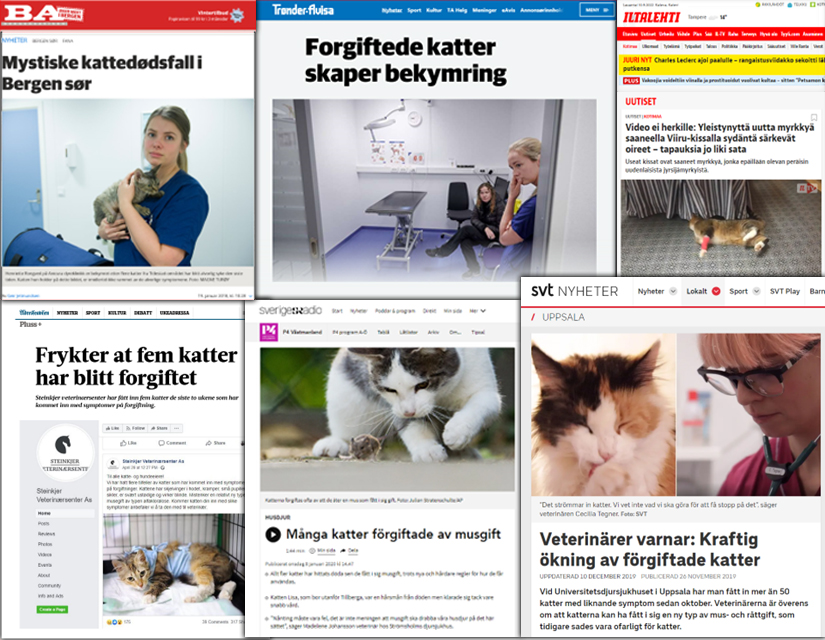1 Introduction
AC is a biocidal active substance that is used in rodenticide baits to control mice. AC has also been used as an avicide and an anaesthetic in clinical practice for human, feline and canine patients as well as laboratory animals, however it is currently not used clinically (1).
For many years the anticoagulants have dominated the Nordic market for control of mice. Based on their reproductive toxicity properties, all anticoagulants meet the exclusion criterion under the Biocidal Products Regulation (BPR – (EU) No 528/2012). Additionally, the 2nd generation anticoagulants meet the exclusion criterion because they are PBT (persistent, bioaccumulative and toxic) or vPvB (very persistent, very bioaccumulating) substances, i.e., they stay in the environment for a long time and accumulate in the food chain. This has led to a strict regulation of these products. AC was approved as a biocidal active substance in 2009 (2009/93/EC) under the Biocidal Product Directive (BPD (98/8/EC) in the European Union, and it has been considered a better alternative than the anticoagulants because it was less persistent and bioaccumulative.
AC containing biocidal products were first authorised for use by both the general public and professionals. As a response to an increased observation of suspected secondary poisoning in cats, the authorisation was restricted to trained professional use only, in Norway by the Norwegian Environment Agency from May 2020 and in Sweden by the Swedish Chemicals Agency (KEMI) from December 2019. In Finland restriction to trained professional use by the Finnish Safety and Chemicals Agency (Tukes) was appealed in December 2021 by the authorisation holders and thus the restrictions are not legally valid (the court case is in progress when finalising this report). In Denmark the products are authorised by the Danish EPA for both professional and public use, but they are restricted to use in bait boxes.
The marked increase in suspected cases of AC-poisoning in cats mentioned above, was reported to national veterinary and chemical authorities and institutes in Finland, Norway and Sweden in 2018 and 2019 by veterinarians working in clinical practices in the respective countries (1,2). This is exemplified by the graph showing annually suspected AC-poisoning cases at the University Animal Hospital, Small Animal Clinic in Uppsala in fig 1, reproduced by permission from the publication by Tegner et al. (2). The medical history led several veterinarians to suspect that the cats were poisoned secondarily from eating poisoned mice (1). The increase in cases led to concern among cat owners, and also received attention in the media (fig 2). The same concern was not reported from Danish chemical authorities, but the Danish EPA have conducted an informal survey where they received a small number of suspected AC-poisoning cases of cats and one dog (personal communication, Jesper Johannesen, Danish EPA).
Figure 1: Number of cats presenting annually to University Animal Hospital, Small Animal Clinic, Uppsala, Sweden, with suspected AC poisoning in 2014–2019 (2). Reproduced from Tegner et al. (2022) by permission from the publisher

Figure 2: Examples of press releases on AC poisoning cases (3)
Only a few scientific publications on AC poisoning in companion animals were available before this surge in suspected cases occurred (4). The suspicion of secondary poisoning cases led to the initiation of several Nordic research projects (1,2,5,6). A recently published study on AC poisoning in cats in three Nordic countries (1) were co-funded by the Nordic council and provides the main scientific foundation to this report. Data on signalment, history and clinical findings were prospectively collected in Finland, Norway and Sweden using a questionnaire which the attending veterinarian completed and submitted together with a sample of blood serum collected from suspected feline cases of AC-poisoning. The diagnosis was confirmed by quantification of AC in the serum. Feline urine samples were screened for AC metabolites, and furthermore, bait intake and amount of AC consumed by wild mice was observed. The aim of this study was to investigate the possibility of secondary AC poisoning in cats from consuming poisoned mice, and to study metabolism and excretion of AC in cats.
More knowledge on the risk of secondary poisoning of non-target organisms, and thus any unacceptable effects on the welfare and health of animals, contributes to a more precise risk assessment of AC as an active substance in rodenticides in the reassessment for approval under the BPR. It should be emphasised that knowledge on the risk of AC poisoning in cats from the use in rodenticide baits to control mice is relevant regarding the risk for poisoning of other wild carnivores and birds of prey.